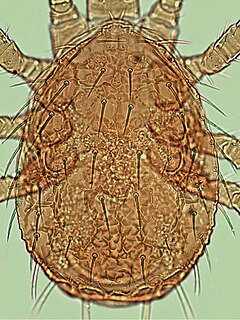
Otters are carnivorous mammals in the subfamily Lutrinae. The 13 extant otter species are all semiaquatic, aquatic or marine, with diets based on fish and invertebrates. Lutrinae is a branch of the Mustelidae family, which also includes weasels, badgers, mink, and wolverines, among other animals.

Leishmania is a genus of trypanosomes that are responsible for the disease leishmaniasis. They are spread by sandflies of the genus Phlebotomus in the Old World, and of the genus Lutzomyia in the New World. At least 93 sandfly species are proven or probable vectors worldwide. Their primary hosts are vertebrates; Leishmania commonly infects hyraxes, canids, rodents, and humans.

Multituberculata is an extinct taxon of rodent-like allotherian mammals that existed for approximately 166 million years, the longest fossil history of any mammal lineage. They eventually declined from the late Paleocene onwards, disappearing from the known fossil record in the late Eocene, though gondwanatheres lived into the Miocene, and may have been multituberculates. More than 200 species are known, ranging from mouse-sized to beaver-sized. These species occupied a diversity of ecological niches, ranging from burrow-dwelling to squirrel-like arborealism to jerboa-like hoppers. Multituberculates are usually placed as crown mammals outside either of the two main groups of living mammals—Theria, including placentals and marsupials, and Monotremata—but closer to Theria than to monotremes. Nonetheless, at least one study found a potential status as sister taxa to monotremes/Australosphenida.

The fugu in Japanese, bogeo (복어) or bok (복) in Korean, and hétún in Standard Modern Chinese is a pufferfish, normally of the genus Takifugu, Lagocephalus, or Sphoeroides, or a porcupinefish of the genus Diodon, or a dish prepared from these fish.

Planctomycetes are a phylum of aquatic bacteria and are found in samples of brackish, and marine and fresh water. They reproduce by budding. In structure, the organisms of this group are ovoid and have a holdfast, at the tip of a thin cylindrical extension from the cell body called the stalk, at the nonreproductive end that helps them to attach to each other during budding.

Apalone is a genus of turtles in the family Trionychidae. Species of Apalone are native to North America.

The Dryomyzidae are a small family of flies ranging from 4–18 mm long, with prominent bristles, and yellow to brown or rust-yellow coloring. The wings are very large. The subcosta is complete and well separated from vein 1. Larvae feed on decaying organic matter - carrion, dung, and fungi. The prelambrum protrudes from the oral cavity. Vibrissae are absent and the postvertical bristles are divergent.

The Northwestern Wildcats softball team is an NCAA Division I college softball team and part of the Big Ten Conference. They play their home games at Sharon J. Drysdale Field in Evanston, Illinois. They have an overall record of 836-629-4.

Emesopsis is a genus of tropical bugs (Heteroptera) from the family Reduviidae. There are at least 22 described species, of which one, E. nubila, also occurs in southern Europe.
Onychomesa is a little-known genus of thread-legged bug in the subfamily Emesinae. Three species have been described, one from India, Japan, and Taiwan.
Gamasellus is a genus of mites in the family Ologamasidae.
Parholaspididae is a family of mites in the order Mesostigmata.
Gamasholaspis is a genus of mites in the family Parholaspididae. There are about 15 described species in Gamasholaspis.
Holaspulus is a genus of mites in the family Parholaspididae. There are about 16 described species in Holaspulus.
Neparholaspis is a genus of mites in the family Parholaspididae. There are about nine described species in Neparholaspis.

Ameroseius is a genus of mites in the family Ameroseiidae. There are more than 60 described species in Ameroseius.

Biwia is a small genus of cyprinid fishes containing four species, three of which are endemic to Japan, and one of which is endemic to Korea.

Lepidoperca is a small genus of fish belonging to the Anthiinae subfamily. It includes ten species.
Alkalibacterium is a genus in the phylum Firmicutes (Bacteria).

The Hexanauplia constitute a class of crustaceans, comprising three groups: the Copepoda, the Tantulocarida and the Thecostraca.












